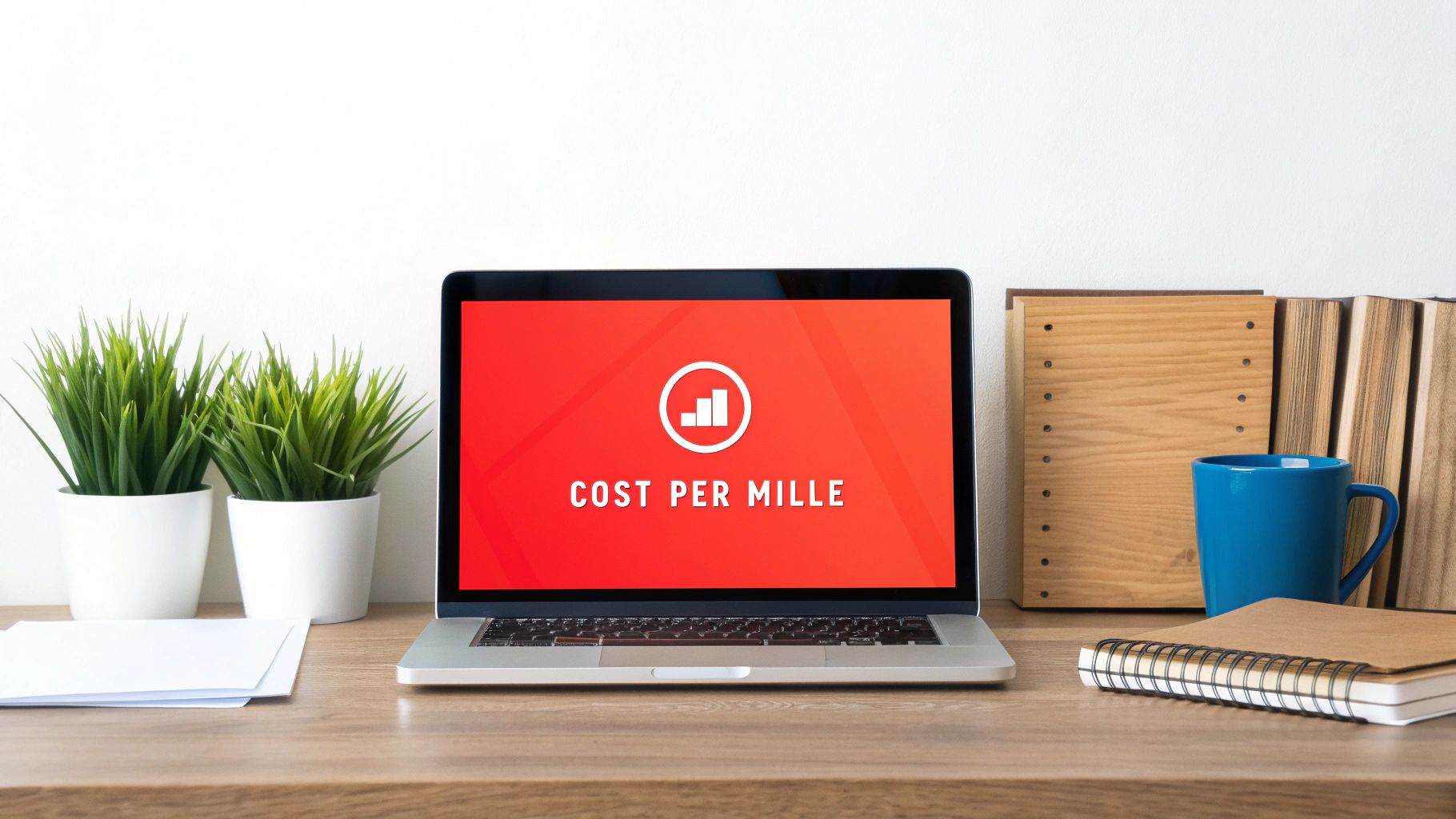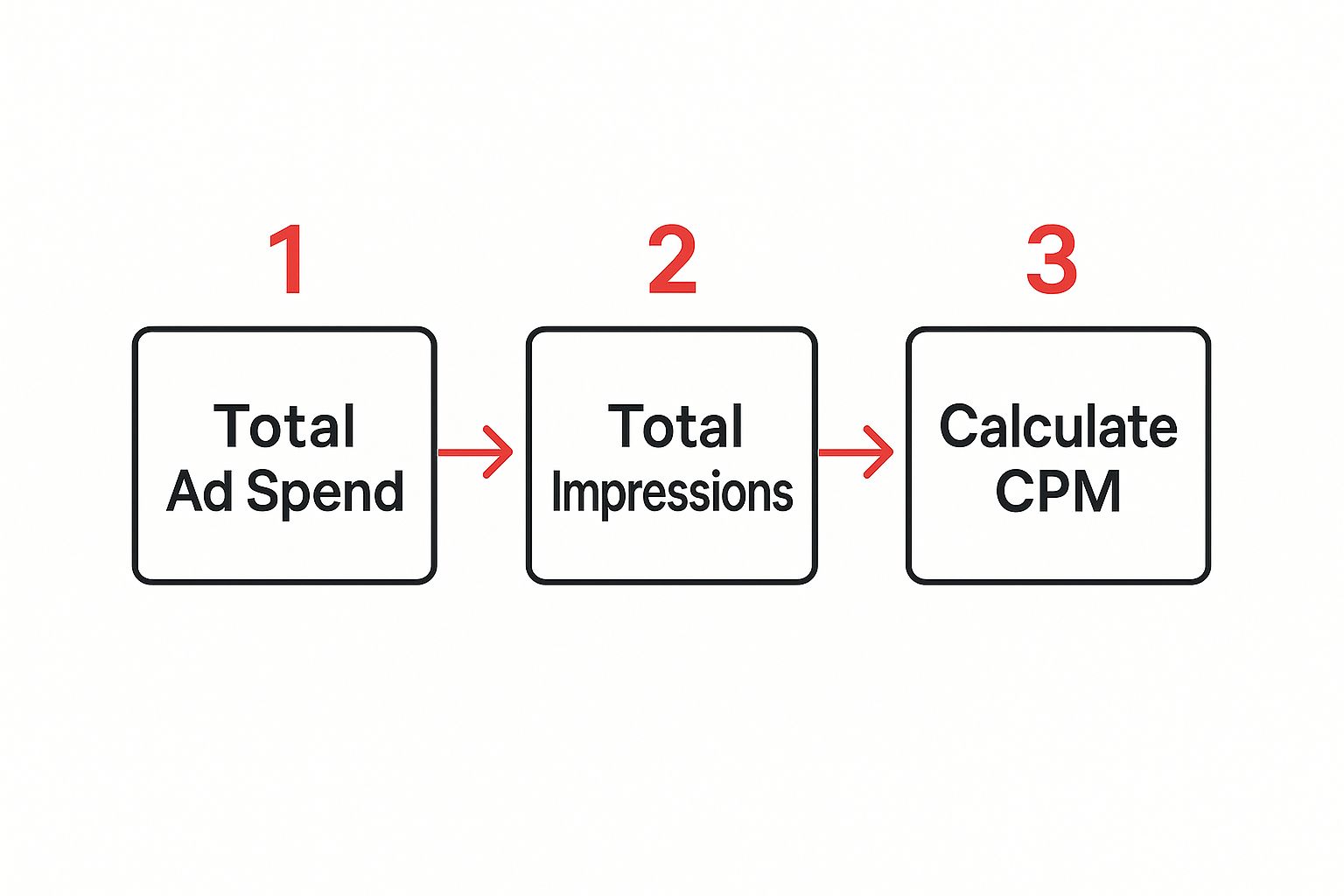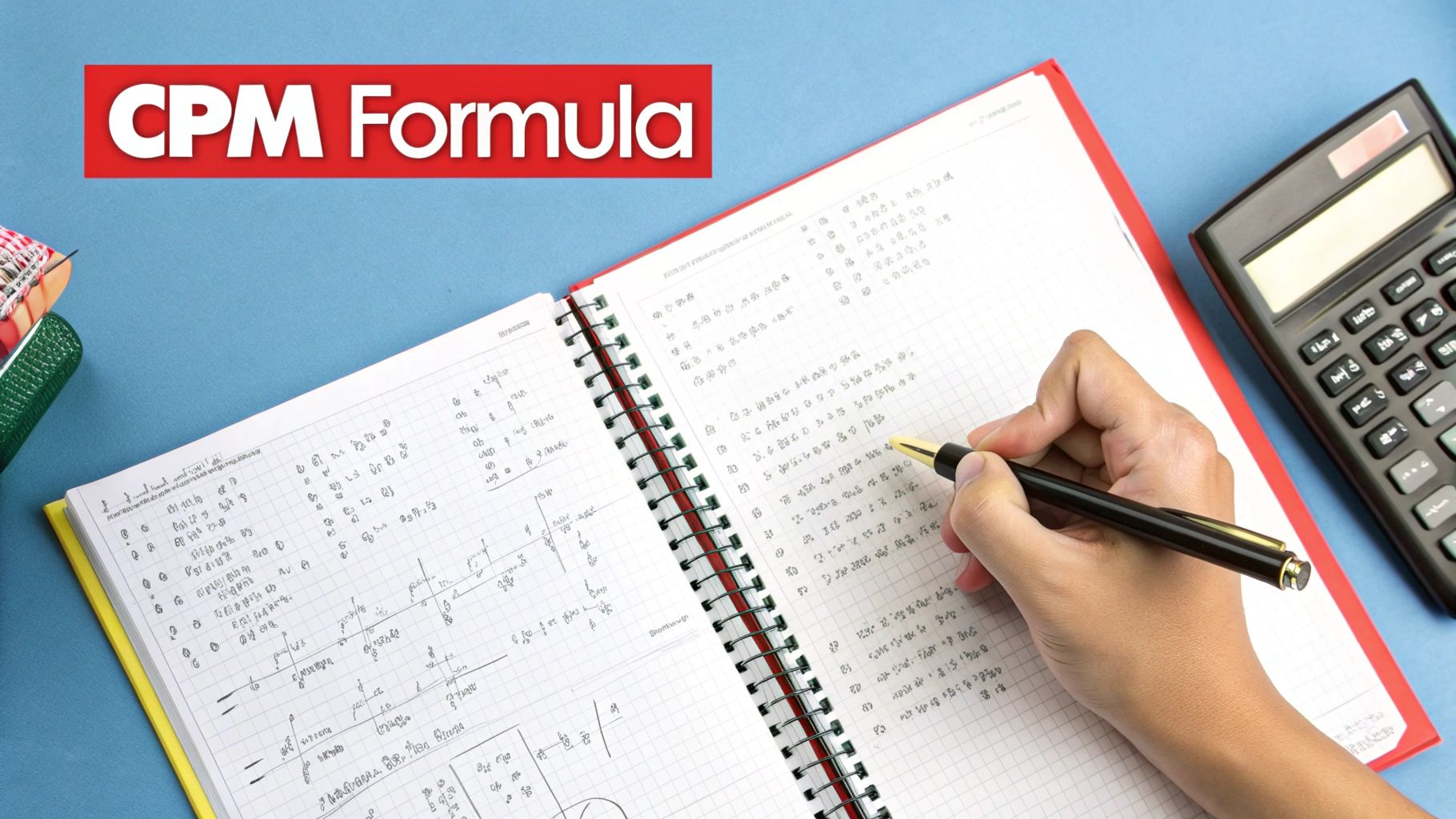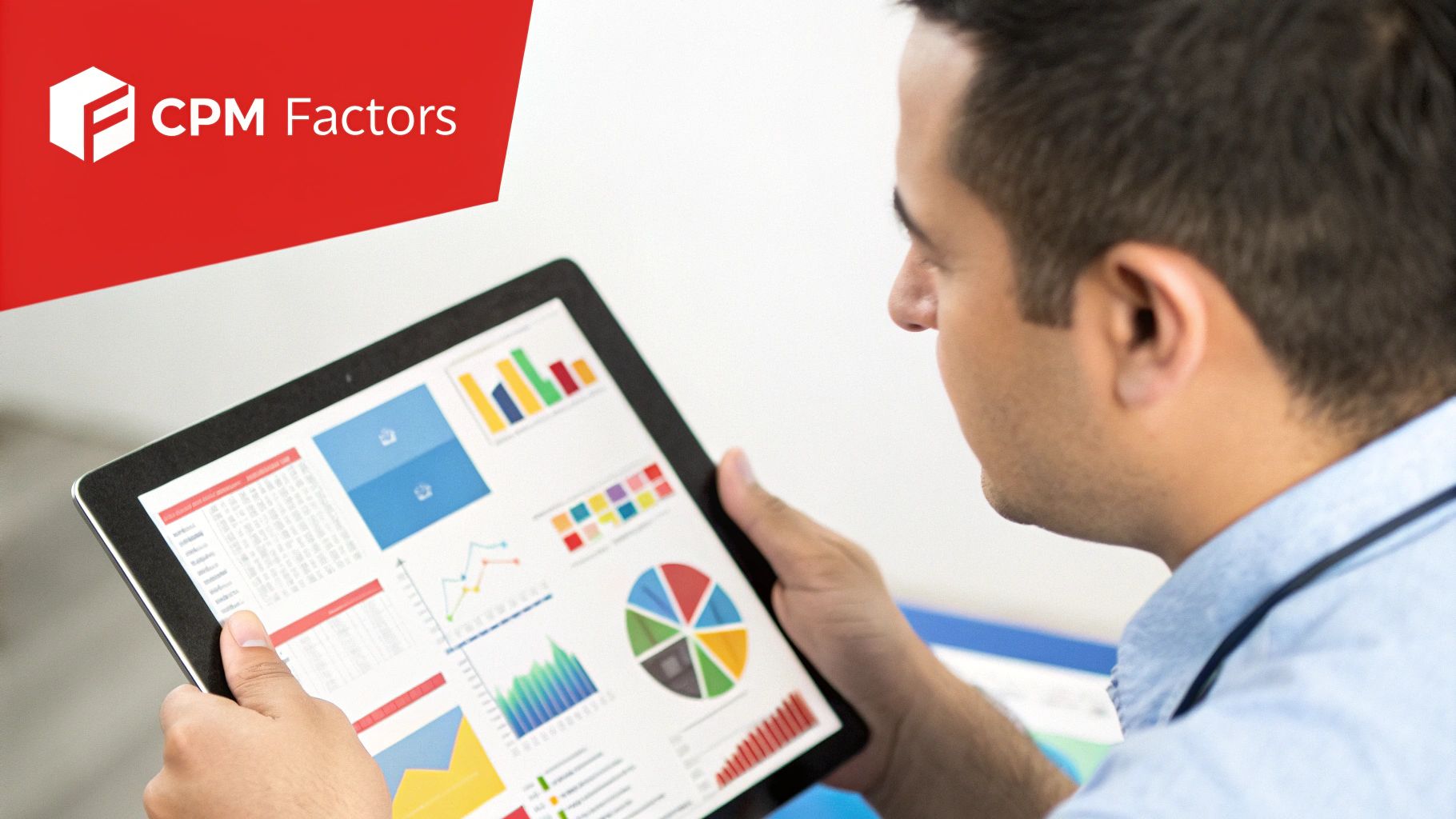Calculating your Cost Per Mille (CPM) is pretty simple. All you do is divide your total ad spend by the total number of impressions, then multiply that number by 1,000. Getting a handle on this basic formula is one of the first steps to figuring out how efficient your advertising really is.
What CPM Is and Why It Matters for Your Budget

In a nutshell, CPM is the price you pay for one thousand views (or impressions) of your ad. The "mille" part is just Latin for thousand, a throwback to the old days of radio and TV advertising when everything was sold in blocks of a thousand listeners or viewers.
Think of it as buying your ad space wholesale. You're not paying for clicks or sales; you're paying for pure exposure. This is why it's such a go-to metric for campaigns where the main goal is just getting your brand name out there and building awareness.
The CPM Formula at a Glance
To make it even clearer, let's break down the formula into its core parts.
| Component | What It Represents | Simple Example |
|---|---|---|
| Total Ad Spend | The total amount of money you spent on the campaign. | You spent $200 on a campaign. |
| Total Impressions | The total number of times your ad was displayed. | Your ad was shown 50,000 times. |
| Multiply by 1,000 | This standardizes the cost to a "per thousand" rate. | This makes it easy to compare across platforms. |
This table gives you a quick reference for plugging your own numbers into the calculation.
Why Every Creator Needs to Understand CPM
For anyone running their own business or creating content, CPM isn't just another piece of jargon—it's essential.
Knowing your CPM helps you:
- Compare costs across channels. Is it cheaper to get 1,000 views on TikTok or on YouTube for your audience? CPM gives you a straight answer.
- Budget with confidence. You can predict how much reach you'll get for a specific budget.
- Track your efficiency. Are your ad costs going up or down? CPM is a great health check for your campaigns.
For new businesses, especially those doing startup marketing on a budget, mastering CPM is a game-changer. It helps you squeeze every last drop of value out of your ad spend.
At the end of the day, CPM is your yardstick for measuring the cost of visibility. By understanding this simple metric, you can make smarter decisions, stretch your ad dollars further, and give your campaigns a real shot at success.
The Simple Math Behind Your CPM Calculation
Figuring out your CPM is surprisingly straightforward. You don't need a complex spreadsheet or a degree in mathematics—just one simple formula that cuts through the noise and tells you exactly what you're paying for eyeballs.
The formula you'll want to remember is: (Total Ad Spend / Total Impressions) x 1,000 = CPM.
Let's quickly break down those terms. Total Ad Spend is pretty self-explanatory; it's the total amount of money you've spent on a particular ad or campaign. Total Impressions, on the other hand, is the number of times your ad has been displayed. It's crucial to remember this is about views, not clicks.
A Real-World Example
Let's put this into practice. Say you're a content creator who just launched a new video series and you decide to promote it with a $500 ad campaign on Facebook. After the campaign wraps up, you see that your ad was shown 125,000 times.
Here’s how you’d calculate your CPM:
- First, divide your cost by your impressions: $500 / 125,000 = $0.004.
- Then, multiply that number by 1,000: $0.004 x 1,000 = $4.00.
Just like that, you have your answer. Your CPM for this campaign is $4.00. This means for every thousand times your ad was seen, you paid four dollars. Now you have a clear benchmark to compare against future campaigns to see if you're getting more efficient.
This visual helps break down the process.

As the infographic shows, all you need are your spending and impression numbers to get your final CPM. It’s a simple input-output calculation.
Key Takeaway: Calculating CPM isn’t just for big brands with massive ad budgets. It’s an essential skill for anyone trying to get the most out of their money, whether you're a solo creator or a small business owner. It turns an abstract ad spend into a concrete measure of cost-effectiveness.
For creators on platforms like YouTube, getting a handle on CPM is also key to understanding and projecting your ad revenue. If you're curious about how different CPMs could affect your bottom line, check out our YouTube money calculator to play with the numbers.
Calculating CPM In Real-World Scenarios

The CPM formula is simple, but putting it into practice is where things get interesting. The number you end up with isn't just a metric; it tells a story about how cost-effective your campaign is in a very specific corner of the internet. Let's run through a few examples to see how this works in the real world.
Say you're running a YouTube video ad campaign to get some eyeballs on your new channel. You spend $1,000, and your ads get in front of people 250,000 times. Using the formula ($1,000 / 250,000) x 1,000, your CPM comes out to $4.00. That number now becomes your baseline, a benchmark you can measure future video campaigns against.
Comparing CPMs Across Different Platforms
Now, let's jump over to a totally different playing field. Imagine you launch a LinkedIn display ad campaign to target B2B professionals. You invest $3,000 and get 100,000 impressions. The math here—($3,000 / 100,000) x 1,000—gives you a $30.00 CPM.
Whoa, that’s a big jump from YouTube, right? But it's actually pretty normal. LinkedIn's audience is incredibly specific, which makes each impression potentially more valuable—and pricier. This is the key takeaway: a "good" CPM is always relative to the platform and what you're trying to achieve.
To round things out, think about a programmatic ad buy across a wide network of blogs. You might spend just $500 and get a massive 500,000 impressions. Your CPM? A tiny $1.00. You're getting incredible reach for your money, but the audience is nowhere near as targeted.
To make this clearer, let's look at these scenarios side-by-side.
Comparing CPM Calculations Across Ad Platforms
Here's a quick look at how CPM plays out in different advertising environments.
| Platform Scenario | Sample Ad Spend | Impressions Generated | Resulting CPM |
|---|---|---|---|
| Broad YouTube Video Campaign | $1,000 | 250,000 | $4.00 |
| Targeted LinkedIn B2B Ad | $3,000 | 100,000 | $30.00 |
| Programmatic Blog Network | $500 | 500,000 | $1.00 |
As you can see, the platform and your targeting strategy have a massive impact on your final CPM.
CPM isn’t a one-size-fits-all metric. A $30 CPM on a targeted platform like LinkedIn can be a great value for reaching decision-makers, while a $4 CPM on YouTube is excellent for broad brand awareness. Your campaign's context defines what makes a CPM successful.
This variability is everywhere in digital advertising. Take Apple Ads, for example. In 2023, the average CPM for its Search tab campaigns was around $4.20, showing how costs can differ even within the same company’s ecosystem depending on placement. For more platform-specific numbers, it's always a good idea to check out reports like this CPM benchmark data from SplitMetrics.
Why The Context Of Your CPM Matters
For creators, understanding your CPM is vital for figuring out what you might earn. The payout rates from platforms can swing wildly based on your content niche and where your audience is located. Our complete reference guide offers a deeper look into this here: https://monetizedprofiles.com/blogs/monetization-on-social-media/youtube-cpm-by-category-complete-revenue-reference-guide
Thinking about CPM also helps when you're exploring different revenue models. For instance, creators can find great ideas by looking into various monetization strategies for webcomics. At the end of the day, calculating your CPM is just the first step—learning to interpret it is what will help you make smarter decisions.
Common Mistakes That Skew Your CPM Data
Nailing the CPM formula is one thing, but feeding it bad data is a whole other problem. I've seen it happen countless times—a simple misstep in the numbers throws off the entire calculation, leading marketers to make the wrong call on a campaign.
A skewed CPM can make a campaign that's killing it look like a total dud, or worse, make a money-pit campaign seem like a winner. It all comes down to the details.
Mistake #1: Confusing Impressions with Reach
This is probably the most common mix-up out there. It’s easy to see why, but impressions and reach are two very different things.
Impressions count every single time your ad is displayed. Reach counts how many unique people saw it. So, if one person sees your ad 5 times, that’s 5 impressions but a reach of only 1. If you accidentally plug your reach number into the CPM formula instead of impressions, you'll end up with a wildly inflated (and completely wrong) CPM.
Mistake #2: Forgetting All the "Other" Costs
Another classic pitfall is only looking at what you paid the ad platform. Your true ad spend is almost always higher than just the media buy. To get an accurate CPM, you have to account for every dollar that went into making that campaign happen.
Think about all the associated expenses:
- Did you pay an agency or a freelancer to run the ads?
- What about the cost of creating the ad itself—the design work, copywriting, or video production?
- Are you using any special analytics or tracking tools for this campaign?
These "soft costs" are part of your real investment. If you ignore them, your total spend looks lower, which makes your CPM seem artificially cheap and efficient. It's not an honest reflection of your performance.
A clean CPM calculation is an honest one. It requires you to be meticulous about both your impression counts and your total expenditure. Only then can you get a truly accurate picture of your ad performance and make informed decisions.
When you're careful about keeping your data clean and your cost calculations complete, your CPM becomes a genuinely reliable metric. This kind of discipline is crucial for good reporting, which you can learn more about in our guide to social media report analysis. It’s what separates guessing from making smart, data-driven decisions.
Knowing When to Use CPM and When to Ignore It

Figuring out the CPM calculation is one thing. The real trick is knowing when this metric actually matters for your goals—and when you should be looking at something else entirely. CPM is just one tool in the toolbox, not the ultimate measure of success for every single campaign.
Think of CPM as your go-to metric for pure brand awareness. If your main objective is simply to get your brand, product, or message in front of as many eyeballs as possible, then a low CPM is a great sign. It tells you you’re getting maximum visibility for your budget, which is exactly what you want for a new product launch or a big announcement.
But the moment your goal shifts from visibility to action, CPM becomes a lot less useful. It measures exposure, not engagement or intent.
Shifting Focus to Action-Based Metrics
When your campaign is built to drive specific results, other metrics need to take the lead. This is where you pivot from what your audience sees to what they actually do.
For action-oriented campaigns, I always look at these instead:
- Cost Per Click (CPC): When you need to drive traffic to a landing page, CPC is way more insightful. It tells you what you're paying for each person who was interested enough to click.
- Cost Per Acquisition (CPA): If the goal is a real conversion—a sale, a lead, a sign-up—CPA cuts right to the chase and shows you the true cost of getting that result.
CPM tells you the cost of a conversation starter, not the cost of a handshake. For campaigns focused on sales or leads, fixating on CPM is like judging a book by how many people walked past it in a bookstore.
One of the longest-standing knocks against CPM is that it only measures served impressions, not whether an ad was truly seen. This blind spot has led some to call it the "original sin" of digital advertising. You can dive deeper into the limitations of CPM on marketingeconomics.substack.com.
Ultimately, a smart analytics strategy uses the right metric for the right job. Use CPM to gauge the cost of your reach, but be ready to switch over to CPC or CPA when you need to measure the cost of action.
Your Top CPM Questions, Answered
Once you get the hang of calculating CPM, a few practical questions almost always come up. Let's walk through some of the most common ones I hear from marketers to clear up any confusion.
What’s a Good CPM, Really?
I get this question all the time, and the honest answer is: there's no magic number. A "good" CPM is completely relative. It all comes down to your industry, who you're targeting, where your ads are running, and what you’re trying to achieve.
For example, reaching a very specific B2B audience on LinkedIn is going to have a much higher CPM than a broad campaign targeting consumers on a social media app. Instead of chasing some universal number you read in a blog post, focus on benchmarking against your own past performance and any industry data you can find. Your own historical data is always the best guide.
A "good" CPM isn't a fixed number you find online; it's a number that's getting better over time. Focus on outperforming your last campaign, not hitting a generic benchmark.
How Do I Lower My CPM?
If you want to bring your CPM down, the name of the game is relevance. Ad platforms are built to reward content that people actually want to see. The more engaging and relevant your ad is, the better placement and lower costs you'll typically get.
Here are a few things you can try right away:
- Sharpen Your Targeting: Don't just target a broad category. Get granular with demographics, specific interests, and online behaviors.
- Upgrade Your Ad Creative: Run A/B tests on your images, videos, and headlines. You’ll be surprised what a small tweak can do to your results.
- Boost Engagement: Ads that get likes, comments, and shares are a huge signal to the platform that you've created something good. This quality signal often leads directly to a lower CPM.
Can I Use CPM for Offline Ads Like Billboards?
Absolutely, though it’s more of an estimate than the precise measurement you get with digital ads. When you're dealing with offline media, the "impressions" figure is always going to be an educated guess.
For print ads, publishers use their circulation numbers as a proxy for impressions. For a billboard on the side of the highway, companies use traffic counts and location data to estimate how many eyeballs might see it each day. The formula is exactly the same, but you have to remember that the impression data is just an approximation.
Ready to skip the slow grind and start earning from your content right away? MonetizedProfiles offers fully approved TikTok and YouTube accounts that are ready to generate ad revenue from day one. Check out our available accounts.









